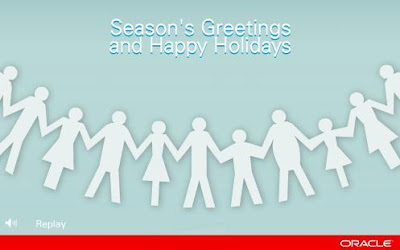
Fusion Middleware 11g is here. If you are interested and only have few minutes, here is the essential info about sessions and agenda.
Regarding Enterprise2.0 and WebCenter11g the announcements will be about WebCenter Spaces, WebCenter Composer, WebCenter Services and WebCenter Framework.
July 1, 2009
Andrew W. Mellon Auditorium
1301 Constitution Ave NW
Washington, D.C., USA
Be the first to learn how the newest release of Oracle Fusion Middleware can serve as a comprehensive platform for your business and IT processes, connecting strategy to success across your enterprise.
You’ll find out how Oracle Fusion Middleware 11g can help:
- Make your business more agile, intelligent and responsive
- Ensure long-term flexibility in heterogeneous IT environments
- Take advantage of modern software and hardware architectures - delivering both cost savings and innovation
Sessions
Oracle WebCenter Suite 11g: Next-Generation Enterprise Portal Delivers Rapid Time-to-Value
In today’s dynamic economy, the ability to be agile in order to respond to change is more important than ever. Oracle WebCenter Suite 11g is a unified, standards-based enterprise portal platform that provides a full range of functionality to develop the Web-based applications you need to maintain a productive, efficient and agile enterprise. See first-hand how WebCenter Suite 11g creates a richer set of connections – among people, ideas, content, processes, systems and enterprise applications – creating a superior experience for both the developer and the business user.
Oracle WebLogic Suite 11g and Application Grid: The Foundation Strengthened
Enterprise IT organizations are under increasing pressure to accommodate two opposing forces: reduce costs, and outperform competitors. An application grid foundation is key to achieving simultaneous efficiency and competitiveness. Innovations to technologies including Oracle WebLogic Server, Tuxedo, Coherence and JRockit strengthen the application grid, enhancing the ability to efficiently utilize hardware and operational resources for the highest performance, reliability, and agility at any scale. Attend this session to learn about new application grid capabilities in Oracle Fusion Middleware 11g and how you can benefit from an application grid architecture.
Oracle Identity Management 11g: Improving Security and Compliance
In this fast growing and dynamic business landscape, building an intelligent security infrastructure is vital to ensure the protection and sustainability of an enterprise and its resources. Oracle Identity Management 11g provides a unique integrated system of security policies, processes and technologies that enable the enterprise to control access to critical resources. Attend this session and learn how Oracle Identity Management 11g’s best-in-class products constitute the most complete solution offered by any vendor.
Oracle SOA Suite 11g: The Foundation for Next Generation Business Applications
Rapid adoption of SOA is resulting in extensive service enabling of IT systems. However, this is only half the story – the only way to achieve IT goals of lower costs, greater efficiency, and increased visibility is through rapidly assembling these services into modular and flexible business applications. Business process management combined with SOA enables even greater potential benefits but may complicate the effort. Attend this session and learn how integrated BPM and SOA with Oracle SOA Suite 11g simplifies the lifecycle of next generation business applications.
Event Agenda
9:00 am Continental Breakfast and Registration
10:00 am FUSION MIDDLEWARE 11g Keynote
Charles Phillips, President, Oracle
Thomas Kurian, Senior Vice President, Oracle Development
11:45 am Customer Panel
12:15 pm Lunch
1:00 - 2:50 pm Information-packed product breakout sessions:
Oracle WebCenter Suite 11g: Next-Generation Enterprise Portal Delivers Rapid Time-to-Value
Oracle WebLogic Suite 11g and Application Grid: The Foundation Strengthened
Oracle Identity Management 11g: Improving Security and Compliance
Oracle SOA Suite 11g: The Foundation for Next Generation Business Applications
